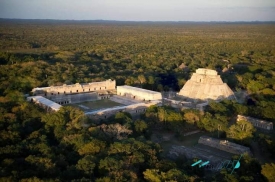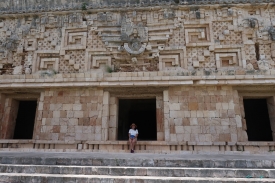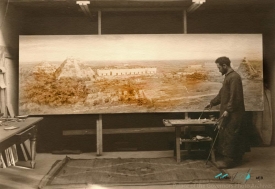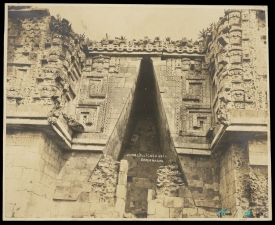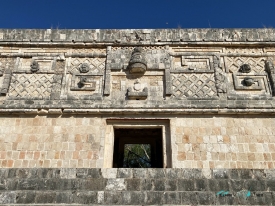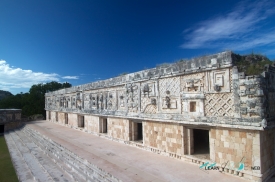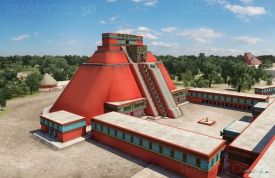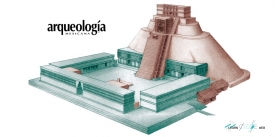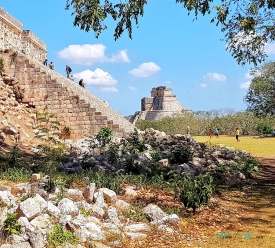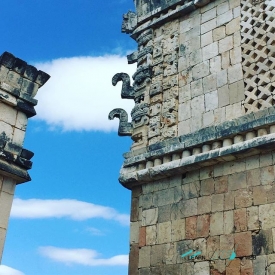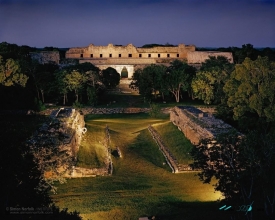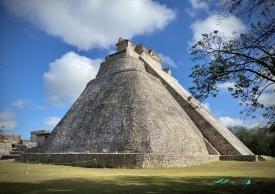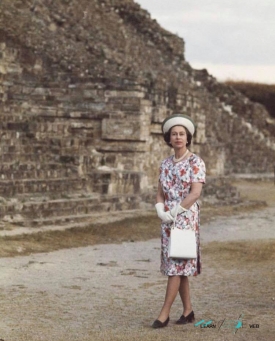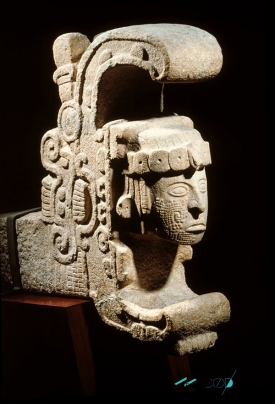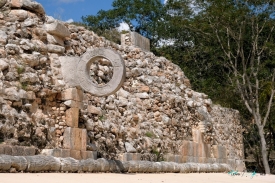The Mayan archaeological site of Uxmal is near the city of Mérida, capital of the state of Yucatán. Uxmal is one of the most important sites in the classical Mayan world, boasting the steepest pyramid in all of Mexico.
The buildings take advantage of the unevenness of the terrain to gain height and in some cases stand out for their volume, such as the pyramid of "El adivino" with five levels.
In “The Pyramid of the Magician” it is also known as that of the sorcerer or the dwarf according to a legend that tells about a dwarf, son of the town witch who was born from an egg. The character, who wanted to reign in the city, made a bet with the governor that he could build a pyramid in one night alone. The pyramid was built and the dwarf was proclaimed governor of the thrice built city of Uxmal.
The Pyramid of the Magician is the largest monument in the city, it is 35 meters high and more than 50 meters wide. It has five structures from different eras.
The governor's palace, which occupies a large area of land, stands out for being arranged on three terraces and surrounded by a plain. It is the great work of ancient Mexico. It consists of three independent bodies, the central one is a rectangular building with 14 accessible chambers, of which 11 can be entered from the outside. On each side stand the two buildings joined by vaults and galleries. At the height of the accesses, the walls are smooth without ornamentation. Above is a decorated border. Also above the central door is the figure of the ruler.
Behind the Pyramid of the Magician is the Quadrangle of the nuns, a very interesting architectural complex. It is a large square courtyard and on each side there are buildings that have chambers that open into the courtyard. The name comes from it because it looks like a convent.
And we also went through the area dedicated to the ball game, it is a smaller area than the ball game that we find in Chichen Itza. It looks deteriorated, but you can still recognize its structure. The ball game was very common in the cultures of Mesoamerica. It had a sporting and religious meaning that made it a mystical ceremony. In the Mayan culture, the game had a meaning of life and death.
The archaeological complex of Uxmal is large. There is much to see: houses, platforms, structures, arches, temples, columns, plazas, paths, small pyramids... there is even a cemetery decorated with skulls. Some elements are well preserved and others not so much.
The construction of the city of Uxmal was carried out in different phases for more than three centuries during the end of the classic Mayan civilization. Marta Foncerrada del Molina, in her book “Radiocarbon dates in the Maya area”, dates the beginning of the construction works of the Pirámide de Adivino in the 6th century, which continues periodically until the 10th century: “This classification refers to the radiocarbon dating at 560 AD (± 50 years) for the lower western part of the temple as in the Foncerrada stylistic dating for the inner temples I and II". In general, the creation of the pyramid can be divided into at least five phases of construction, in which the various components are traditionally called "temple", which says nothing about their actual function.In doing so, the Maya followed a traditional practice in pyramid construction: they enlarged the dimensions step by step by adding new sections of construction to existing construction stages. As the pyramid stands today, it is the result of five nested temples. Parts of the first temple are visible by climbing the west stairway. You can enter the second and third temples from the east stairway, through an inner chamber on the second level. The third temple forms a narthex in front of the fourth temple. The fourth temple is clearly visible from the west side. Climbing the eastern stairway to the top reveals the Fifth Temple, located above the Second and Third Temples.
The Spanish friar Diego de Landa, who visited the already abandoned city of Uxmal in the 16th century, was speechless. He would be the first to collect data on the enclosure, according to what the inhabitants of the area told him. In the 17th century it would be another friar who went to continue investigating and named the buildings. In the 19th century, the Austrian Jean Frederic Walfdeck arrived and with drawings he made and the information he obtained wrote a book that was published in 1838: "Picturesque and archaeological journey in the province of Yucatan", being the first time that the Mayan art and culture.
The contents of the book attracted researchers, as well as adventurers, to Uxmal. Undoubtedly the main and most important of the 19th century was that of the research team: John Lloyd Stephens, who was in charge of studying buildings and culture, Freferik Cathrwood made illustrations and Samuel Cabot studied fauna. The purpose of everything was to carry out an extensive study of the entire Yucatan area and they began with Uxmal, which already had prior documentation. This first trip would be followed by others, and later taking photographs. And thanks to all these expeditions we know something more about the Maya of Uxmal. Later there were other researchers who expanded the knowledge that was had and already in the middle of the 20th century the restoration of the site began.
The buildings take advantage of the unevenness of the terrain to gain height and in some cases stand out for their volume, such as the pyramid of "El adivino" with five levels.
In “The Pyramid of the Magician” it is also known as that of the sorcerer or the dwarf according to a legend that tells about a dwarf, son of the town witch who was born from an egg. The character, who wanted to reign in the city, made a bet with the governor that he could build a pyramid in one night alone. The pyramid was built and the dwarf was proclaimed governor of the thrice built city of Uxmal.
The Pyramid of the Magician is the largest monument in the city, it is 35 meters high and more than 50 meters wide. It has five structures from different eras.
The governor's palace, which occupies a large area of land, stands out for being arranged on three terraces and surrounded by a plain. It is the great work of ancient Mexico. It consists of three independent bodies, the central one is a rectangular building with 14 accessible chambers, of which 11 can be entered from the outside. On each side stand the two buildings joined by vaults and galleries. At the height of the accesses, the walls are smooth without ornamentation. Above is a decorated border. Also above the central door is the figure of the ruler.
Behind the Pyramid of the Magician is the Quadrangle of the nuns, a very interesting architectural complex. It is a large square courtyard and on each side there are buildings that have chambers that open into the courtyard. The name comes from it because it looks like a convent.
And we also went through the area dedicated to the ball game, it is a smaller area than the ball game that we find in Chichen Itza. It looks deteriorated, but you can still recognize its structure. The ball game was very common in the cultures of Mesoamerica. It had a sporting and religious meaning that made it a mystical ceremony. In the Mayan culture, the game had a meaning of life and death.
The archaeological complex of Uxmal is large. There is much to see: houses, platforms, structures, arches, temples, columns, plazas, paths, small pyramids... there is even a cemetery decorated with skulls. Some elements are well preserved and others not so much.
The construction of the city of Uxmal was carried out in different phases for more than three centuries during the end of the classic Mayan civilization. Marta Foncerrada del Molina, in her book “Radiocarbon dates in the Maya area”, dates the beginning of the construction works of the Pirámide de Adivino in the 6th century, which continues periodically until the 10th century: “This classification refers to the radiocarbon dating at 560 AD (± 50 years) for the lower western part of the temple as in the Foncerrada stylistic dating for the inner temples I and II". In general, the creation of the pyramid can be divided into at least five phases of construction, in which the various components are traditionally called "temple", which says nothing about their actual function.In doing so, the Maya followed a traditional practice in pyramid construction: they enlarged the dimensions step by step by adding new sections of construction to existing construction stages. As the pyramid stands today, it is the result of five nested temples. Parts of the first temple are visible by climbing the west stairway. You can enter the second and third temples from the east stairway, through an inner chamber on the second level. The third temple forms a narthex in front of the fourth temple. The fourth temple is clearly visible from the west side. Climbing the eastern stairway to the top reveals the Fifth Temple, located above the Second and Third Temples.
The Spanish friar Diego de Landa, who visited the already abandoned city of Uxmal in the 16th century, was speechless. He would be the first to collect data on the enclosure, according to what the inhabitants of the area told him. In the 17th century it would be another friar who went to continue investigating and named the buildings. In the 19th century, the Austrian Jean Frederic Walfdeck arrived and with drawings he made and the information he obtained wrote a book that was published in 1838: "Picturesque and archaeological journey in the province of Yucatan", being the first time that the Mayan art and culture.
The contents of the book attracted researchers, as well as adventurers, to Uxmal. Undoubtedly the main and most important of the 19th century was that of the research team: John Lloyd Stephens, who was in charge of studying buildings and culture, Freferik Cathrwood made illustrations and Samuel Cabot studied fauna. The purpose of everything was to carry out an extensive study of the entire Yucatan area and they began with Uxmal, which already had prior documentation. This first trip would be followed by others, and later taking photographs. And thanks to all these expeditions we know something more about the Maya of Uxmal. Later there were other researchers who expanded the knowledge that was had and already in the middle of the 20th century the restoration of the site began.



